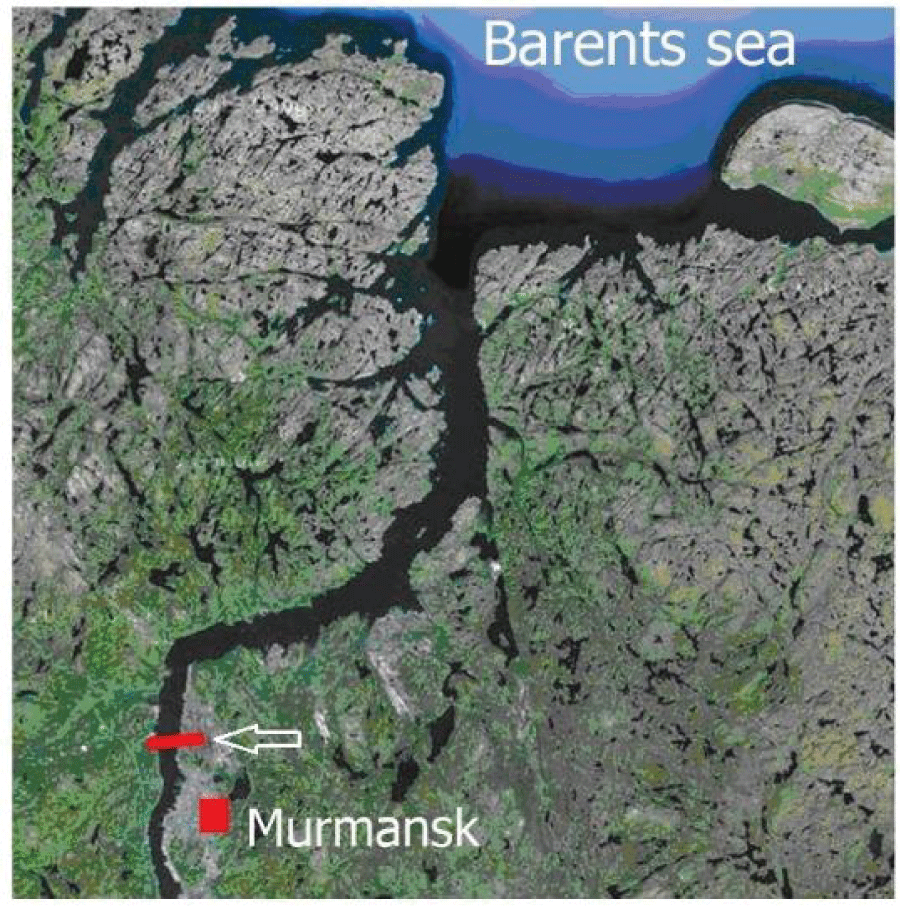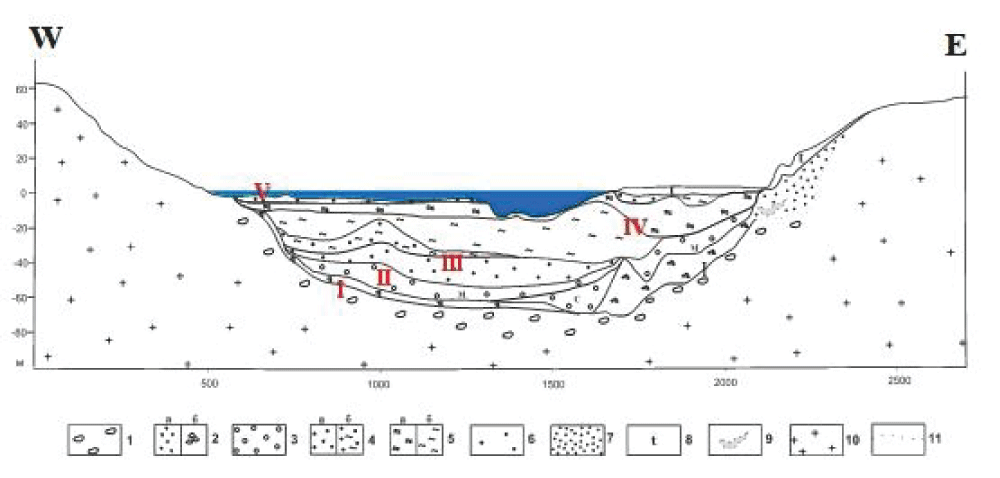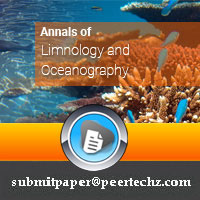Annals of Limnology and Oceanography
First Data on the Structure and Lithological Composition of the Kola Fjord (Bay) Deposits Section
EV Shipilov* and EA Kovalchuk
Polar Geophysical Institute of the Kola Scientific Center of the Russian Academy of Sciences, 15 Khalturina Str., Murmansk, 183010, Russia
Cite this as
Shipilov EV, Kovalchuk EA. First Data on the Structure and Lithological Composition of the Kola Fjord (Bay) Deposits Section. Ann Limnol Oceanogr. 2024;9(1):005-008. Available from: 10.17352/alo.000016Copyright
© 2024 Shipilov EV, et al. This is an open-access article distributed under the terms of the Creative Commons Attribution License, which permits unrestricted use, distribution, and reproduction in any medium, provided the original author and source are credited.Studying the materials from drilling of engineering-geological wells and other data the structure of a sedimentary cover of the Kola fjord on its total thickness is for the first time lighted. The characteristics of the structure and lithological composition of a section of deposits, and the main forms of a relief of the underlying crystalline substrate are provided. Situations of the formation of deposits and the graben structure of the gulf are considered. It is noted that the deglaciation has served as the trigger mechanism that has started processes of the differentiated block uplift, development of fracture, and a fault formation which has caused initial “exogenous” phases of neotectonic destruction of crust. The horizontal movements have led to the stretching of the earth’s crust and separation of blocks with a graben formation in Kola Bay according to the authors with the influence of stress fields coming from developing young oceanic spreading basins.
Introduction
Kola Bay is located on the coast of the Barents Sea, which is an elevated, dissected denudation plain 150-200 m high, rising to the south and steeply breaking off to the north (Figure 1).
According to the geomorphological classification, this section of the Murmansk coast belongs to the fjord coast type [1]. Fjords are narrow, long, and deep bays with rocky shores and steep underwater slopes. Their internal structure is characterized by the presence of one or more underwater thresholds, including at the mouth, dividing the bottom of the fjord into several internal basins. In Russia, similar bays are also found on Novaya Zemlya, the Chukotka and Kamchatka peninsulas, and the Koryak Highlands. In the world, typical fjords are common in Scandinavia, on the Spitsbergen archipelago, in Greenland, and on the Pacific coast of South America. The problems of the origin and formation of fjords have been considered by many authors [2]. These issues are the subject of a monograph [2], which briefly describes all the fjord regions of our country and examines the possible causes of their formation. Nevertheless, the problem of the genesis and time of formation of fjords remains controversial, due to their poor study and the virtual absence of data on their internal structure.
The proposed work is based on the results of studying and analyzing the data from engineering-geological drilling, bathymetric maps, as well as a field survey of its coast. The conducted studies made it possible to compile a transverse geological section of the southern part of the fjord (Figures 1,2) illuminating the structure of sediments almost to the full capacity.
The obtained data, especially in terms of the structure and lithological composition of the sediments filling the southern part (southern knee) of Kola Bay, seem to allow us to supplement the existing ideas about the origin and conditions of the formation of the fjords of the Kola Peninsula and Scandinavia.
Glacial deposits: Complex I - 1 - moraine deposits with predominantly boulders and sand filler; 2a - moraine rubble deposits with sand filler; 2b - gravel deposits with pebbles, rubble, and sand filler.
Glacial-marine deposits: Complex II - 3 - sands of varying sizes of glacial-marine origin s - medium, m - fine;
Complex III - 4a - siltstones, 4b - siltstones with silt interlayers.
Marine deposits: Complex IV - 5a - sandy loam silt, 5b - loamy silt;
Complex V - 6 - medium-sized marine sands.
7 - medium-sized alluvial sands, 8 - technogenic deposits, 9 – silt lens with frequent silt interlayers;
10 – crystalline basement rocks; 11 – conditional boundary.
General geological and geomorphological situation
The Kola Bay is an elongated sub-meridional tectonic structure, the outlines of which are characterized by geniculate bends caused by the participation in its structure and formation of faults of north-northwestern and northeastern strikes. Geologically, the Kola Fjord is located in two areas: the northern one is represented by Archean granitoid, and the southern one by mica and garnet gneisses. Ancient rocks are covered by Quaternary deposits, represented by facies of the youngest Upper Valdai moraine. At the same time, alluvial (in the valleys of the Tuloma and Kola rivers), diluvial-eluvial, glacial, and fluvioglacial, and marine (late and postglacial) formations have developed [3-5]. Glacial and marine deposits are the most widespread.
Following the bends, the water area of the bay is divided into 3 sections: northern, middle, and southern knees [6,7].
The length of the bay along the alignment lines is 58.7 km, while the straight distance from the entrance to the top is 51 km. The width, if measured without taking into account the side branches, gradually decreases from 3.0 km - 3.5 km in the northern knee to 1.5 - 2.5 on average and 1.0 - 1.5 in the southern. The ratio of the fjord width to its length is even higher than the average for the fjords of the Barents Sea and is 0.05.
The depth of the bay decreases from the entrance to the top, but this trend is disrupted by underwater thresholds.
The depths at the entrance to the southern knee are 25 - 35 m, and towards the shores and the top of the bay, they decrease. In the northern part of this area, there are several depressions with depths of 40 - 62 m.
In recent years, the relief of the southern knee has changed due to anthropogenic activity, in particular dredging and soil reclamation in drainage areas for the construction of various structures.
Composition and structure of sediments of the southern knee of the Kola Bay
The thickness of the Quaternary deposits averages 50 - 100 m, reaching more than 200 m at the exit from the bay. The deposits of the southern knee of the fjord include man-made formations (alluvial and bottom), modern marine sediments, and glacial deposits (Figure 2). The deposits of the Quaternary cover lie on bedrock, which is represented by fine-grained fractured granite-gneisses of a light gray color. The latter has not been exposed by wells in the water area of the bay, but according to vertical electrical sounding data, they lie in this part of the bay at a depth of more than 100 m and are exposed on the daylight surface of its western and eastern shores [8].
Glacial sediments (complex I) are represented by moraine deposits with sand filler, the maximum exposed thickness of which is 39.2 m, and the lowest elevation of their roof is 87.0 m. Three layers can be distinguished in these deposits, presumably of late Valdai age. The first is dominated by boulders (50% - 55%), ranging in size from 20 - 30 cm, occasionally about 1.5 m, containing large crushed stone and debris (10% - 15%) and sand filler - everywhere underlies all the overlying layers. The second - crushed stone, lying on the roof of glacial deposits, has the greatest thickness of 5.1 m at the western edge and pinches out to the east. The content of boulders reaches 20% - 25%, and the filler is fine sand, in places of silt. The third layer is composed of gravel and pebbles with gravelly sand and boulder inclusions up to 20%. The maximum exposed thickness is noted closer to the central part of the depression and is 32.2 m. The size of the fractions decreases up the section.
According to some data, the moraine may be underlain by a layer of complex interbedded washed-sorted sediments, which are compared with the formations of the Middle Valdai interstadial [3].
On the unevenly eroded roof of Complex I there are sands of varying sizes of glacial-marine origin (Complex II). In the brownish-gray sands, there is often oblique bedding, shell detritus, and isolated boulders. The size of the sands decreases upwards along the section. Their thickness in individual wells can reach 24.0 m. According to its configuration and position in the section, this complex can be characterized as syngraben, the depocenter of which was shifted to the eastern part of the fjord, where it envelops the stepped relief of the underlying substrate. Taking into account the available data on the paleoseismicity of this part of the Kola Peninsula [9], the beginning of its formation is estimated at 8-9 thousand years ago, when, in general terms, the transverse graben-like profile of the Kola Fjord appeared.
Above is a layer of sediments (complex III) represented by gray silts and silts with interlayers and lenses of loamy silt up to 10 cm thick. Its distinctive feature is that before pinching out in the area of the western side of the fjord, it experiences a swelling of thickness (over 20 m) and some bending associated with the attenuation of the last, most noticeable, tectonic impulse that caused the gravitational sliding of the base block (rotational?) from the western shoulder. Under its pressure, the formation of the antiform in question probably occurred. In addition, the effect of selective erosion of sediments is not excluded. To the east, the pinching out of this complex occurs not far from the depocenter of this part of the fjord so that it overlaps the roof of Complex II. This complex is likely post-graben, filling a paleo-depression after the sedimentation depocenter moved to the west. The interlayers of loamy silts indicate that the sedimentation conditions were close to relatively deep water and periodically isolated stagnant.
Marine deposits are represented by complexes IV and V. Complex IV is composed of a loamy silt layer at the bottom, the thickness of which increases toward the eastern shore with a maximum of about 36 m. The color of the deposits is bluish-gray and dark gray. The rare presence of shells and debris and black spots of organic matter are noted. As it moves to the east, this layer sharply pinches out and is covered by a second layer of deposits of the same complex. This layer contains dark-grey to black sandy silts with black streaks and dark nests of organic matter, which contain thin layers of silt, sandy loam with shell fragments, and rare gravel. The maximum thickness of the layer is 22.3 m, but to the west, it decreases to 1.4 m. A characteristic feature of the complex as a whole is that its depocenter is again located in the eastern part of the fjord.
Complex V crowns the sediment section, lying on the surface as a thin layer in which medium-sized sands of marine origin are present. Its distribution is disrupted in the central part due to dredging.
Final remarks
The presented data allow us to formulate some conclusions regarding the history of the formation of the Kola Fjord.
It seems that initially, on the site of the modern fjord, there was a system of faults of northeast and sub-meridional extension, complicating the more ancient pattern of faults of general north-west orientation. It can be said that along the faults of the northern strike, shear movements of right-sided kinematics occurred, which caused, even with a minimum amplitude, the formation of a knee-shaped system of fracture and crush zones. During the period of maximum development of the Wurm (Valdai) glaciation (18 - 20 thousand years ago), the Kola Peninsula and the Barents Sea shelf were covered by continental ice 300 - 700 m thick and shelf glaciers [10]. This suggests that the considered system of fracture and crush zones was subject to exaration activity with the formation of worked-out trough-shaped valleys with corresponding moraine-type deposits. Later, in the process of deglaciation of the Kola Peninsula and the removal of the glacial load, which ended around the turn of 10 - 11 thousand years, its dome-shaped uplift was outlined, which provoked different amplitude vertical movements of blocks. The stresses accumulated in the earth’s crust during these oscillatory processes found an outlet in the form of earthquakes, which are imprinted in various types of paleoseismic dislocations with an age of 8 - 9 thousand years [9].
In the Kola Fjord, there are graben-like scarps, especially clearly expressed in its eastern side zone, to which the depocenter of detritus accumulation of complex II is close. At the same time, in the initial phase, the main source of demolition was the eastern shoulder of the fjord, in the lower part of which deposits of the type of horst foothills were formed. Transverse thresholds, localized near faults of the NW strike, divided the fjord into several isolated basins. In the process of further development and sedimentation, a consistent increase in the thickness of the sediment complexes and migration of sedimentation depocenters from one side to another is noted.
- Kaplin PA, Leontyev OK, Lukyanova SA, Nikiforov LG. Shores. Moscow: Mysl; Series “Nature of the World”. 1991;480.
- Kaplin PA. Fjord coasts of the Soviet Union. Moscow: Publ of the USSR Academy of Sciences; 1962;188.
- Evzerov VYa, Koshechkin BI. Paleography of the western part of the Kola Peninsula. Leningrad: Nauka; 1981;104.
- Lavrova MA. Quaternary geology of the Kola Peninsula. Moscow-Leningrad: Publ Academy of Sciences of the USSR; 1960;233.
- Nikonov AA. Relief development and paleography of the Anthropogene in the west of the Kola Peninsula. Leningrad: Nauka; 1964;182.
- Map. Kola Bay. Moscow 1:50000 along the 690 parallel. St. Petersburg: State University of Oceanology and Oceanography of the Ministry of Defense of the Russian Federation; 2000.
- Gudimov AV, Frolov AA. Littoral bottom communities of the estuary of the Tuloma River and the inner part of the bay. Kola Bay: Oceanography, Biology, Ecosystems, Pollutants. Apatity: KSC RAS; 1997;256.
- Mitrofanov FP, Pozhilenko VI, Arzamastsev A, Lyubtsov VV, Shipilov E, Nikolaeva S, Svetlana Z, Fedotov ZA. Geology of Kola Peninsula. 1995;145.
- Nikolaeva SB. Seismogenic deformations in sediments of the early Holocene terrace of the Pechenga River (Kola Peninsula). Report Acad Sci. 2006;406(1):69-72. Available from: https://www.google.com/search?q=10.1134%2FS1028334X06010028&oq=10.1134%2FS1028334X06010028&gs_lcrp=EgZjaHJvbWUqBggAEEUYOzIGCAAQRRg70gEHNDYyajBqN6gCALACAA&sourceid=chrome&ie=UTF-8
- Matishov GG. The World Ocean and the Glaciation of the Earth. Moscow: Mysl'; 1987;272.
Article Alerts
Subscribe to our articles alerts and stay tuned.
 This work is licensed under a Creative Commons Attribution 4.0 International License.
This work is licensed under a Creative Commons Attribution 4.0 International License.




 Save to Mendeley
Save to Mendeley
